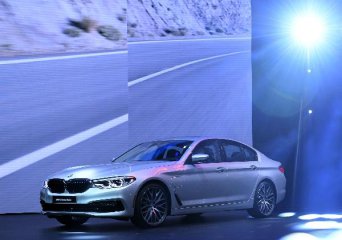
The world’s biggest market for electric vehicles wants to get even bigger, so it’s giving automakers what amounts to an ultimatum. Starting in January, all major manufacturers operating in China—from global giants Toyota Motor and General Motors to domestic players BYD and BAIC Motor—have to meet minimum requirements there for producing new-energy vehicles, or NEVs (plug-in hybrids, pure-battery electrics, and fuel-cell autos). A complex government equation requires that a sizable portion of their production or imports must be green in 2019, with escalating goals thereafter.
The regime resembles the cap-and-trade systems being deployed worldwide for carbon emissions: Carmakers that don’t meet the quota themselves can purchase credits from rivals that exceed it. But if they can’t buy enough credits, they face government fines or, in a worst-case scenario, having their assembly lines shut down.
“The pressure is mounting,” says Yunshi Wang, director of the China Center for Energy and Transportation at the University of California at Davis. “This could be a model for other countries; it could be a game changer globally.”
That would help it reduce a dependence on imported oil and blow away the smog choking its cities. It would also help domestic automakers gain more expertise in a car manufacturing segment that’s burgeoning globally.
Electric Vehicle Sales
Given the size of the Chinese market, the largest for cars overall and for EVs, auto companies will have to rapidly accelerate their development and manufacturing efforts to meet the targets. By 2025, China’s leaders want 7 million cars sold every year, or about 20 percent of the total, to be plug-in hybrids or battery-powered.
The world’s largest automaker is certainly taking notice. Volkswagen AG, which sold just under 40 percent of its vehicles in China last year, says it will introduce about 40 locally produced NEV models in China within the next decade.
BMW AG, which sells more cars in China than anywhere else, makes two plug-in hybrids there and plans to produce two pure-electric cars, including the iX3 SUV, starting in 2020. Yet some companies will struggle to reach the goals under their own steam. “Carmakers are both technically and commercially not ready for a ramp-up in EV production to the level of the quotas,” says Sophie Shen, an automotive analyst at PwC in Shanghai.
So they’re turning to a wide range of solutions to avoid falling short. Ford Motor Co., which lost $378 million in China in the third quarter, is teaming up with Zotye Automobile Co., a minor domestic player, to jointly produce cars eligible for the credits, Asia-Pacific President Peter Fleet said in October. Ford will introduce at least 15 hybrids and EVs in China by 2025. Vehicles sold through the Zotye partnership will have a new brand name.
Some rivals, however, are putting their names on the same generic car. Toyota, Fiat Chrysler Automobiles, Honda Motor, and Mitsubishi Motors all plan to sell the same electric SUV, developed by Guangzhou Automobile Group, to Chinese drivers. Other than brand-specific pricing and specifications, the models will be largely identical. That’s not ideal in an industry that prizes distinctive marketing, but it’s a necessary compromise until the companies develop their own technologies.
While carmakers have plenty of regulatory reasons to flood Chinese showrooms with EVs, it’s not clear that consumers will want them. Electric cars remain considerably more expensive than their gasoline counterparts everywhere; in China, where gasoline cars such as Chongqing Changan Automobile Co.’s Benben Mini model sell for as little as 29,900 yuan ($4,300), the difference can be especially pronounced.
For now, government subsidies for EVs cover much of that gap, running to as much as $7,900 for an all-electric vehicle with a range longer than 400km. That can offset almost one-third of the sticker price of a BYD e5 electric car.
The incentives, though, are being phased out and will disappear in 2021. That could mean a risky several years for automakers, since battery costs aren’t expected to be truly price-competitive with internal combustion engines until 2024 to 2028, depending on a vehicle’s type and the region of the globe where it’s sold, according to BNEF.
Still, the government has other levers should demand fall short. Several of the largest cities, including Beijing, Shanghai, and Shenzhen, limit the number of cars on their roads by restricting the issuance of new license plates. In those metropolises, simply acquiring the right to purchase a car can be pricey. A plate for a traditional gas guzzler costs as much as $14,000 in Shanghai. But if a consumer decides on an EV instead, it’s free.
BNEF already expects 2.5 million passenger EVs to be sold in China in 2022. But if similar restrictions take off in other cities, particularly the rapidly growing industrial hubs of the interior, EV growth could be even more dramatic.
For the moment, domestic models will mostly remain confined to the Chinese market. “Right now a lot of the cars selling in China have zero brand value outside of China,” says Janet Lewis, the head of industrials and transportation research for Asia at investment bank Macquarie Capital. But the EVs that are successful in the early-adopting mainland market may eventually help China develop the manufacturing and branding expertise it will need to export more vehicles to other countries, experts say.
China undoubtedly will tweak its credit-and-subsidy regime as it seeks to encourage an electric-first domestic auto industry. The minimum thresholds of the cap-and-trade system for 2021 and beyond haven’t been laid out, though they’ll have to rise rapidly to meet government sales targets for NEVs.
Source: Bloomberg





















Latest comments